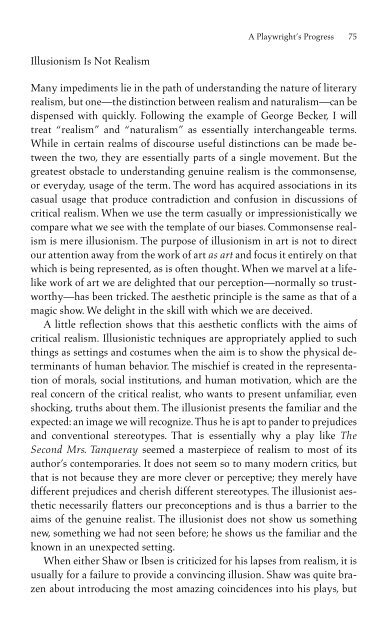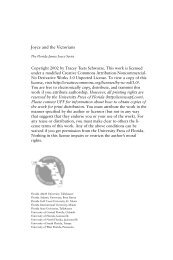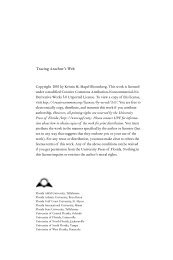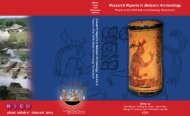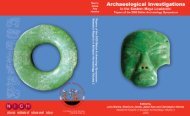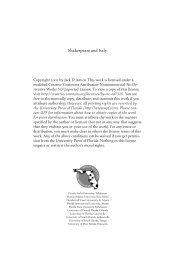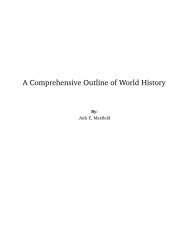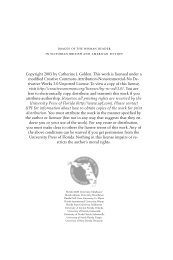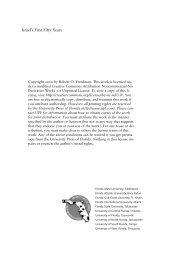Bernard Shaw's Remarkable Religion: A Faith That Fits the Facts
Bernard Shaw's Remarkable Religion: A Faith That Fits the Facts
Bernard Shaw's Remarkable Religion: A Faith That Fits the Facts
You also want an ePaper? Increase the reach of your titles
YUMPU automatically turns print PDFs into web optimized ePapers that Google loves.
Illusionism Is Not Realism<br />
A Playwright’s Progress 75<br />
Many impediments lie in <strong>the</strong> path of understanding <strong>the</strong> nature of literary<br />
realism, but one—<strong>the</strong> distinction between realism and naturalism—can be<br />
dispensed with quickly. Following <strong>the</strong> example of George Becker, I will<br />
treat “realism” and “naturalism” as essentially interchangeable terms.<br />
While in certain realms of discourse useful distinctions can be made between<br />
<strong>the</strong> two, <strong>the</strong>y are essentially parts of a single movement. But <strong>the</strong><br />
greatest obstacle to understanding genuine realism is <strong>the</strong> commonsense,<br />
or everyday, usage of <strong>the</strong> term. The word has acquired associations in its<br />
casual usage that produce contradiction and confusion in discussions of<br />
critical realism. When we use <strong>the</strong> term casually or impressionistically we<br />
compare what we see with <strong>the</strong> template of our biases. Commonsense realism<br />
is mere illusionism. The purpose of illusionism in art is not to direct<br />
our attention away from <strong>the</strong> work of art as art and focus it entirely on that<br />
which is being represented, as is often thought. When we marvel at a lifelike<br />
work of art we are delighted that our perception—normally so trustworthy—has<br />
been tricked. The aes<strong>the</strong>tic principle is <strong>the</strong> same as that of a<br />
magic show. We delight in <strong>the</strong> skill with which we are deceived.<br />
A little reflection shows that this aes<strong>the</strong>tic conflicts with <strong>the</strong> aims of<br />
critical realism. Illusionistic techniques are appropriately applied to such<br />
things as settings and costumes when <strong>the</strong> aim is to show <strong>the</strong> physical determinants<br />
of human behavior. The mischief is created in <strong>the</strong> representation<br />
of morals, social institutions, and human motivation, which are <strong>the</strong><br />
real concern of <strong>the</strong> critical realist, who wants to present unfamiliar, even<br />
shocking, truths about <strong>the</strong>m. The illusionist presents <strong>the</strong> familiar and <strong>the</strong><br />
expected: an image we will recognize. Thus he is apt to pander to prejudices<br />
and conventional stereotypes. <strong>That</strong> is essentially why a play like The<br />
Second Mrs. Tanqueray seemed a masterpiece of realism to most of its<br />
author’s contemporaries. It does not seem so to many modern critics, but<br />
that is not because <strong>the</strong>y are more clever or perceptive; <strong>the</strong>y merely have<br />
different prejudices and cherish different stereotypes. The illusionist aes<strong>the</strong>tic<br />
necessarily flatters our preconceptions and is thus a barrier to <strong>the</strong><br />
aims of <strong>the</strong> genuine realist. The illusionist does not show us something<br />
new, something we had not seen before; he shows us <strong>the</strong> familiar and <strong>the</strong><br />
known in an unexpected setting.<br />
When ei<strong>the</strong>r Shaw or Ibsen is criticized for his lapses from realism, it is<br />
usually for a failure to provide a convincing illusion. Shaw was quite brazen<br />
about introducing <strong>the</strong> most amazing coincidences into his plays, but


